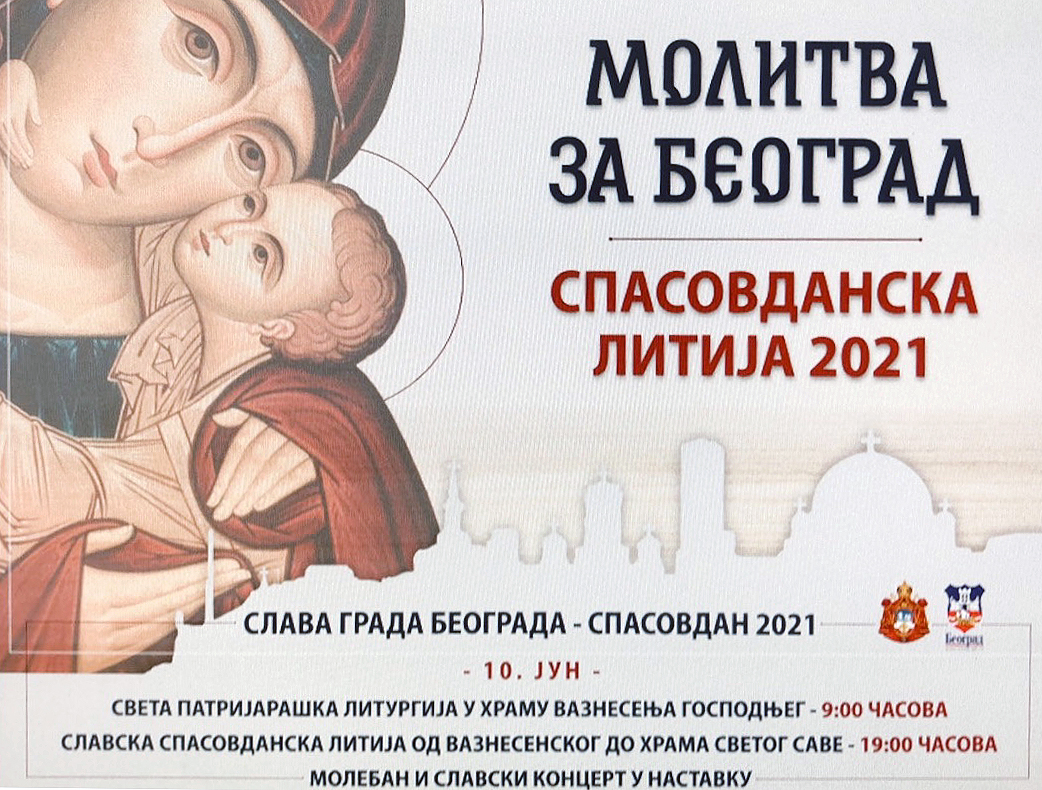The Patron-Saint day of the City of Belgrade: Ascension Day Procession
 Along with the invitation to the faithful Orthodox people of the capital of Belgrade to take part in a procession that will go from the Ascension Church to St. Sava Cathedral, on Patron Saint-day- The Ascension Day, June 10, 2021, at 7 pm, we bring an exceptional text by protopresbyter-staurophor Dr. Vladimir Vukasinovic, regular professor of teh Faculty of Orthodox Theology of the University of Belgrade:
Along with the invitation to the faithful Orthodox people of the capital of Belgrade to take part in a procession that will go from the Ascension Church to St. Sava Cathedral, on Patron Saint-day- The Ascension Day, June 10, 2021, at 7 pm, we bring an exceptional text by protopresbyter-staurophor Dr. Vladimir Vukasinovic, regular professor of teh Faculty of Orthodox Theology of the University of Belgrade:
The Belgrade Procession
Procession is a special public and common worship, or part of a larger worship component, which consists of an entrance procession and appropriate prayers that accompany it. The expression, term, procession originates from the Greek language, where it originally meant any prayer or supplication, but in the fifth century it began to take on the meaning of prayer in a special liturgical procession, and from the tenth became a technical term for those processions.
Such universal, common and solemn liturgies were an integral part of the liturgical life of the great Christian capitals, in the first place Constantinople and Rome, but also other centers of church and public life. Liturgical processions were performed in the streets of the city, accompanied by the singing of psalms and hymns, as well as the utterance of prayers and supplications. The liturgies would usually end with the Eucharistic worship on the feast days, that is, by entering the church where it would be performed.
It is worth knowing that, in addition to these processions outside churches, processions are also called two church service expressions: the daily procession for the dead and the procession during the All-night Vigil. Some important feast days in the liturgical year also contain processions such as Lazarus' Saturday and the Matine of Holy Saturday.
Processions, in addition to regular ones, were also performed in emergency situations - during enemy attacks, natural disasters and other troubles. Then they were performed as a special kind of fervent prayer for the Lord to save his people, and then, when the people's prayers were answered, as an expression of gratitude which, most often, turned into an annual remembrance of God's good deeds.
It is customary to perform liturgies around churches or in the places where they are located, even on the days of church celebrations. They are performed today after the Holy Liturgy in order to extend the all-sanctifying grace of the Holy Spirit, which descended on the Eucharistic Gifts and the people of God in the church, in this way to everything that surrounds the church and all those who live in that area. That is why, on that occasion, it is sprinkled with consecrated water on all four corners of the world so that all who participate in the liturgy will be reborn, sanctified, renewed and blessed.
We can perform processions at any time of the day. It is logical that the Church will choose the time that will suit most of her spiritual children so that as many faithful people as possible can take part in this important worship service.
By participating in the procession, we confess our faith in the fact that in the prayer life of the Church, time is not only blessed - that is why we celebrate certain special feast days, separating them from the other days and dedicating them to the Lord. We do the same with space, walking in prayer in the community of faith and love, spreading the light of the word of God and His help and protection to everyone and everything. In this way, everything is blessed, reborn and healed: ourselves and our lives, the legs of the participants and the eyes of the observer, the throats of the singers and the ears of those who listen to them, our hands with which we lead our children in the liturgical procession and children's hearts. worship, in fact, we do not forbid them to approach with joy the invisible Leader of the procession: Christ the God-man, Risen and Ascended.
Orthodox Serbs have been performing procession and participating in them since the old times. They were mentioned back in 1318 by the Serbian Archbishop Nikodim in his famous Typikon.
When Despot Stefan Lazarevic proclaimed Belgrade his new capital in 1405, one of the ways in which it was announced, marked and celebrated was the solemn city liturgy, which we, in fact, continue.
Today, it is our turn to take part in it.

